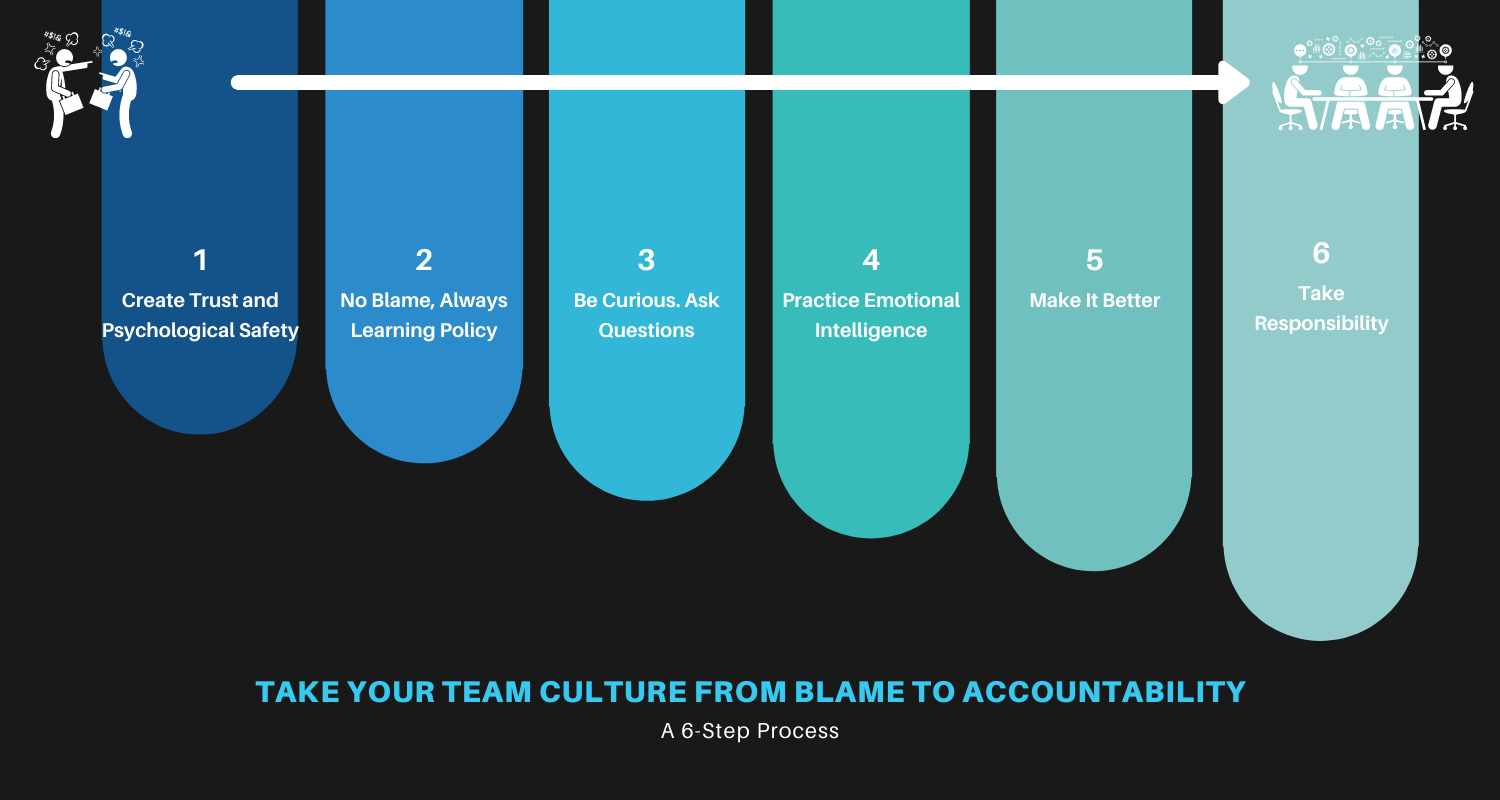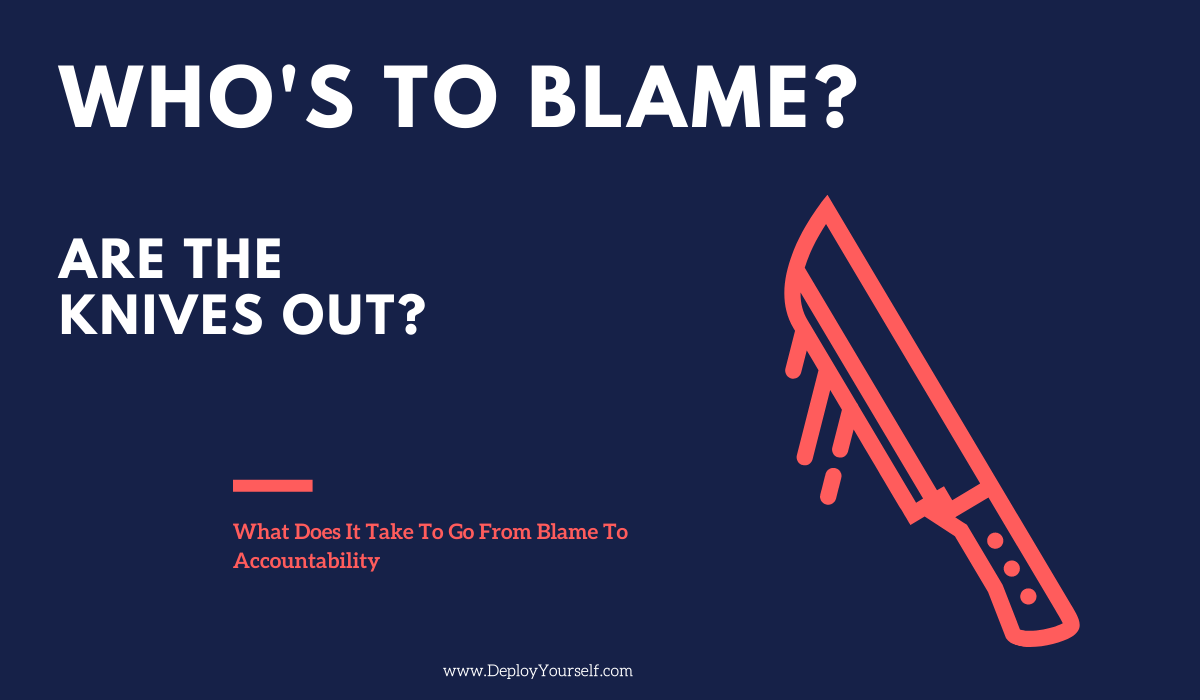Culture plays a key role in determining an organization’s overall performance. It determines how employees interact with others within and outside the organization and give them a sense of direction. Ironically, executives rarely give culture the attention it deserves, and the consequences are always detrimental. If you fail to shape your culture, the culture will shape you and your business results.
If your culture is working against your organization’s goals and objectives, you may need to change your style of doing things. One sign of a bad culture you should look out for is the tendency to assign blame. When something goes wrong, the default in blame culture for many is to point fingers. Instead of trying to understand the problem, they direct their attention to finding the culprit in an attempt to get the problem off their shoulders. However, the culture of blame only succeeds in sweeping the problem under the carpet and never at fostering accountability.

Why Blame Doesn’t Work
Accountability is taking responsibility for the outcome, whether positive or negative. On the other hand, blame only takes shortcuts by closing the mind and quashing the need to understand the system better and finding the root cause. Such narrow thinking shifts focus away from the actual problem to the individual, failing to acknowledge the role the bigger system and culture played in what happened.
Blame culture is more about ego-pleasing and getting the weight off your shoulders (psychologically) instead of the accountability of the person being blamed. Assigning blame shifts the responsibility from yourself to others, boosting your ego. When you attribute a good outcome to your personal characteristics, you get a confidence boost. Also, by attributing a bad outcome to the failure of outside forces, you protect your self-esteem and absolve yourself.
Blame stops learning, as people get defensive and hold onto their positions. As a consequence, both the individual and the organization do not enjoy the benefits of learning from their mistakes. In a culture of blame, people start hiding mistakes, which is even worse. On the other hand, accountability means recognizing that anybody can err and viewing mistakes as opportunities for learning and growing.
Reducing the problem to the fault of one individual is trying to simplify a complex issue without seeing the bigger picture. This is what blame does. It focuses on the past and not on the future with the aim of punishing the offender in the hope that they will rectify their behaviour. Conversely, accountability is forward-thinking. It means taking responsibility for the successes and the failures and learning from the mistakes to better your results in the future.
Blame also destroys trust and psychological safety in the workplace and makes people recoil back to their cocoons. It makes people fear their leaders and each other, creating mistrust. The fear takes away an employee’s confidence making it harder for them to take any initiative. As a result, they lack the courage to handle obstacles. Additionally, when people spend their time defending their turf and pointing fingers, they waste valuable time and hinder cooperation.
A hallmark of a healthy creative culture is that its people feel free to share ideas, opinions, and criticisms. Lack of candor, if unchecked, ultimately leads to dysfunctional environments.
— Ed Catmull, President of Pixar

From Blame Culture to Accountability: How to Get There
As you must have realized by now, it is critical to creating a culture of accountability in any organization. The following are 6 steps to take your team culture from blame to accountability.
1. Create Trust and Psychological Safety
Creating a safe environment is the first step in creating trust and psychological safety. When people feel safe, trust builds, and people interact with each other without being suspicious. This interaction breeds cooperation, which is key to an organization’s success. Without trust, it is difficult to bring people together.
Employees who enjoy psychological safety in the workplace will be more open about their mistakes and more willing to learn from them. They will perform their duties and responsibilities without fear and judgment, taking the organization a step closer to achieving its objectives.
Gordon Bethune joined Continental Airlines when the company was losing hundreds of millions and successfully transformed it into a respectable leader in the airline business. He advises CEOs to take over the responsibility of creating a safe working environment for their employees. In his time at continental, Gordon always took the time to visit his employees in their crew room or the baggage room.
2. Create a No-Blame, Always-Learning Policy
Focusing on the person instead of the problem shifts attention away from the real issue and prevents learning. Once you identify the culprit, the next step is usually how to deal with them. As a result, further inquiry into the problem ceases, hampering effective problem-solving. Finger-pointing denies the organization information about the reality on the ground and makes decision making impossible.
When you focus on accountability, you don’t assign blame to individuals. Instead, you view mistakes as opportunities to facilitate learning and growth and encourage constructive conversations that seek to find the root of the problem. People appreciate this and are more willing to share and discuss their mistakes and challenges in such an environment.
Akio Morita was an innovator and co-founder of Sony. When speaking about his success at the company, he highlighted communication as one important ingredient for success. One of his popular quotes reads: “I believe one of the reasons we went through such a remarkable growth period was that we had this atmosphere of free discussion.” Morita also created a culture of accountability by trusting in his employees’ ability—he believed that everyone had creative abilities.
3. Be Curious. Ask Questions To Figure Out Why The Problem Happened?
A blame culture will tempt people to ask, “Who did it?” but a culture of accountability encourages people to find out the root of the problem by asking more important questions related to the problem. For example, they will ask, “Why did it happen?” “What did we ignore?’’ What could we have done to prevent this?’’
You need to be constantly curious (and not jump to conclusions). Asking these questions encourages openness and inspires constructive engagement. Consequently, it spurs meaningful conversations and encourages a collective approach to addressing the problem from happening again in the future.
Accountability focuses on addressing the problem from a system’s perspective that will enable you to identify flaws in the system, which may not be obvious at first glance. When holding accountability conversations, be clear about your intentions from the onset and remember to focus on inquiry rather than an inquisition. Also, encourage everyone to accept the role they played in the system.
Pixar’s Ed Catmull attributes his company’s (Pixar) success to feedback. The company makes films through a deeply collaborative process that hinges on productive feedback. Such feedback is based on trust and focuses on moving the project forward rather than expressing personal opinions.

4. Build and Practice Emotional Intelligence
Anger is a natural emotional response that you have when something goes wrong or when you experience unfairness and injustice. Although it is an involuntary response, you can always listen to what it has to say, and then respond in a way you can be proud of. Otherwise, the emotion can consume you, making you do things you will later regret. For instance, anger can make you lash out at others unfairly.
Instead of aggravating the problem, remain calm and focus your energy on addressing the problem. Always demonstrate this to set the right example for your team. It is important for them to know that assigning blame is destructive in the workplace. Coach them to deal with their anger and frustrations without blaming others.
When conflict situations arise in the workplace, people tend to justify their behaviour and point of view while failing to consider the other person’s side of the story to escape blame. However, it is your responsibility to discourage this trend in your organization. You can achieve this goal by creating a safe environment that values empathy over blame. Always encourage your team members to listen first, and then express their concerns without holding back.
Alan Mulally exceeded expectations when he turned around Ford Motor from a company that was progressively going out of business to a giant that dominated the industry. He realized that teamwork was the only way out of the mess and led by example in appreciating everyone’s contribution. He also encouraged his team to open up about their failures and support each other.
5. Make It Better
After identifying the problem, you need to figure out what you can do to prevent it from recurring. Ask yourself what you could have done to prevent the problem? After looking inward, engage your team and work together to find what you can tweak in the processes, tools, and systems to prevent a similar problem in the future.
Sometimes problems arise due to a lack of clear expectations. Take this opportunity to communicate your expectations clearly and concisely. If your team does not fully understand their roles and responsibilities, go through them again together. You also need to review their progress constantly and provide regular feedback.
Steve Jobs, who co-founded Apple from his mother’s garage, faced an ouster in 1985. When he came back to Apple in 1997, the company was struggling to survive, and its stock prices had taken a dip. Instead of blaming others for his exit, he used his unique vision and ideas to turn the company around. By the time he died, Apple’s stocks had increased by more than 9,000%.
6. As a Leader, Take Responsibility for Your Team’s Actions
A good leader will accept blame when things go wrong and pass along the credit when things go right. When others face problems, they will learn by using each mistake as an opportunity. Before pointing fingers, they will ask themselves what they could have done differently. If someone slips up, they will offer their support and create a more robust system. Instead of throwing people under the bus, they realize that everyone is human and can make a mistake.
As a leader, the buck stops with you. If you lead by example, you can encourage your team not to fear mistakes but to view them as opportunities to learn and grow. You will also inspire them to emulate your actions, which will include taking responsibility for their mistakes. But if you are constantly pointing fingers, you will lose their trust and respect. You have to lead by example.
Blame Statements
When blame is prevalent in your team culture, you will hear people make statements (either out loud or to themselves) like the below:
- Who did this? This is wrong and should not have happened. Let’s find out who did it.
- This is completely wrong. You should not have done this.
- This is your fault and there will be consequences.
- I made a mistake but I won’t say anything and try to hide it, otherwise, I might face repercussions.
Accountability Statements
When your team culture is one of accountability, you will hear people say:
- How can we make sure that this kind of mistake doesn’t happen again? What processes/systems can be changed?
- What can we learn from this situation?
- What was really the cause of this? Do we know the root cause? How do we plan to fix the problem?
- I made this mistake. I want to share with everyone so that no one makes this mistake and can learn from my experience.
Conclusion
Blame culture creates divisions and separates people and teams. It also causes mistrust between employees and creates an environment of fear. Consequently, it makes it harder for the organization to achieve its goals. Fear also paralyzes workers, making them reluctant to take new initiatives.
Accountability culture brings everyone together as part of a bigger whole. It encourages people to take blows for each other as comrades and friends rather than as competitors. Since it addresses mistakes from a systems point of view, identifying flaws and rectifying them becomes easier.

Trackbacks/Pingbacks